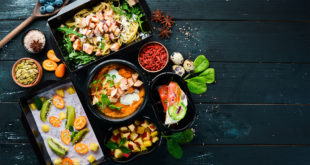
When it comes to fine dining, a casual lunch, or a midnight snack, does the age of certain foods make all the difference?
The discussion surrounding fresh-from-the-ground ingredients and finely-aged wine, appetizers, and entrees is an ongoing one. As ridiculous as it sounds, choosing your side may ostracize you from certain high-brow circles, but deciding to hyperdecant a wine and also enjoy dry aged beef is a personal choice.
That said, knowing what’s on the table when it comes to your options is always a good idea, so here are three instances in which a food or drink’s age can play with the palate:
1. Decanting & Aerating vs. Hyperdecanting Wine
The tricks to enjoying wine are almost as varied as the grapes used in different vintages. Wafting delicate aromas and letting subtle flavors tickle the tongue are common practice, but possibly the most important piece of the wine puzzle is letting the liquid breathe – a process known as decanting.
Technically speaking, decanting is simply pouring a liquid from one container to another, with the purpose of leaving unwanted sediment in the original container. This also allows for aeration and softening of an otherwise bitter or lingering taste.
Pouring wine from a newly-uncorked bottle into a decanter and letting it oxidize for a few hours before service is the traditional method of decanting. In addition to decanting, the process of forcefully pouring wine into a decanter (aeration) quickens the effect. Decanters for wine and spirits come in a range of designs and sizes, and many boast features that are supposed to improve the evolution from bottle to glass. No matter the size or style, traditional decanters are meant to hold a wine for an extended period of time, while it naturally aerates and softens, and purists wouldn’t have it any other way.
The extreme way of letting a wine breathe, and a fairly new concept, is a method known as hyperdecanting. Hyperdecanting is the process of oxidizing a wine using an immersion or kitchen blender, and it’s turning more than a few heads for its unflinching rebellion to wine etiquette. What’s essentially decanting on steroids, hyperdecanting takes the hours-long process of aeration from traditional decanting and condenses it into quick bursts of bubbles. Infusing a fresh-poured wine with so much oxygen is like pushing the hand on a clock forward, and skeptics of hyperdecanting are often surprised at how well the method works to open up flavors and subdue a bitter bite.
Here’s a video of a wine connoisseur newly converted to the hyperdecanting method:
2. Wet vs. Dry Aging Beef
Fresh-from-the-floor beef is often called “green” in the same sense that fresh-from-the-tree firewood is green. It’s alive, tough, and not quite primed for its purpose. That’s why beef is softened up, broken down, and prepped for your plate through a process called aging. Aging beef allows natural microbes and enzymes to go to work on the meat’s connective tissue and muscle. This, in turn, makes the beef more tender and flavorful. Depending on how you’d like the end result to turn out, dry aging or wet aging beef really boils down to personal preference.
When it comes to beef, dry aging is the traditional method. If you’ve ever seen an entire side of a cow hanging by hooks in a cooler you’re looking at meat being dry aged. Dry aging calls for beef to be left in a refrigerated area with a constant air flow to help control bacteria, and a temperature ranging from 36 degrees to freezing is considered best practice. If temperature is too high your meat will spoil, and if it’s too low your meat will freeze. While dry aging, a side of beef’s juices start to evaporate, and the more juices lost the more “beefy” the meat becomes as the same amount of muscle fiber now has less water. Keeping humidity up, somewhere around 85 percent, is a good way to save those tasty juices long before you seal them in on a skillet. The weight loss that occurs during the dry aging process is also part of the reason it’s so expensive per pound, and the longer beef is left to age the higher the risk of spoilage and continued weight loss.
On the flip side, wet aging beef retains most (if not all) of the juices from a cut of beef. Unfortunately, what you retain in weight you lose in portion size. The process of wet aging can’t accommodate an entire side of beef, and smaller cuts are vacuum sealed instead. Vacuum sealing/wet aging a piece of beef doesn’t allow it to breathe or dehydrate, as with dry aging, and breaking down in its own blood and juices has been said to cause a stronger, more sour flavor. As unappealing as that sounds, at least 90 percent of all beef bought by Americans has been wet aged, so once again, it’s all about choice and preference. Wet aged beef is less expensive, and the process is faster than traditional dry aging. As with many things, convenience over quality tends to be the argument.
That said, while dry aging is preferred for something like ribs, the method can’t accommodate certain cuts of beef like skirt and chuck steaks. Deciding what works best for your home or restaurant is key.
3. Raw vs. Dehydrated Fruits and Vegetables
Simply put, time takes its toll on fresh fruits and vegetables quickly. Leave an apple sitting on a warm countertop for even an afternoon and the fruit starts to look a little worse, and reaching into a week-old produce bag of once-fresh lettuce leafs is anything but satisfying. What’s worse, some fruits and vegetables actually make others ripen faster when paired together; almost as if they’re fighting against you in a war on freshness. As an alternative to constantly buying fresh produce many consumers choose to dehydrate nature’s candy to make it last longer and serve specific purposes. To make an informed decision knowing how the dehydration process affects a food’s nutrients and calorie count is important.
Dehydration is the technique of removing moisture from foods, and when done correctly dehydrating fruits and vegetables can make them last for months and even years. In fact, USA Emergency Supply claims they opened up cans of food 15-30 years old and were pleasantly surprised by the results. Much like wine, the ways to dehydrate foods vary depending on your preference. Sun drying, oven drying, and using a professional dehydrator are all popular methods.
During the dehydration process temperatures are warm enough to remove moisture, but not cook or burn the food. As with dry aging beef, air circulation and humidity are important to preventing a stagnant environment where microorganisms can thrive. If humidity is too high and temperature is too low, you’re essentially ripening fruits and vegetables faster without the benefits of dehydration. If humidity is too low and temperature is too high the outside layer of the food will harden and prevent the inside from drying properly. Sufficiently dried fruits and vegetables should be hard and brittle.
Unfortunately, the heat needed to dry produce also saps some of the nutritional value from your farm-fresh favorites. Vitamins A and C are especially heat sensitive, and you lose a substantial amount (anywhere from 20-50%), simply by dehydration. As counter-intuitive as it may be to the organic mindset, chemical treatments like sulfur dioxide have been used before dehydrating to protect Vitamin A and C, but the treatment destroys Vitamin B1. There are also more natural pre-treatments such as hot water blanching or dipping foods in citrus juice. It seems no matter the method of your pre-treatment you’re going to lose some nutritional value during the dehydration process, and just how much is dependent on the type of produce.
One thing you won’t lose when dehydrating fruits and vegetables is calorie count. The number of calories present in one apple is the same number of calories present in one dehydrated apple, and the same goes for vegetables. With that in mind, measurement makes all the difference, and depending on how you portion your produce you could be doubling or even tripling your caloric intake. For example, one cup of fresh grapes has around 100 calories, while a dried cup of the same grapes (raisins) has over 400 calories. That’s a significant difference! This is great for athletes or outdoor enthusiasts who burn a lot of calories and need to replenish on the go, but it’s bad for the weight watcher who just ate three cups of raisins in one sitting.
 Corner Booth Blog | TundraFMP Restaurant Supply, News & Equipment Blog
Corner Booth Blog | TundraFMP Restaurant Supply, News & Equipment Blog



